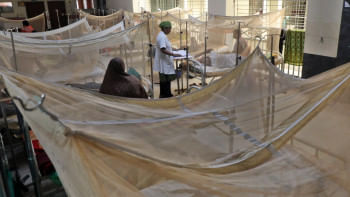Creating research-capable institutions in Bangladesh

Is it possible for Bangladesh to create research-capable institutions similar to ones that are already playing a key role in other Asian countries, driving rapid economic development in the knowledge-intensive era of the fourth industrial revolution?
Today, knowledge is the new currency. East Asia and Southeast Asia are being increasingly recognised as knowledge centres producing high quality research. Although their journey in research is relatively recent, they have fared well, driven by a knowledge seeking culture, in vying with the world's elite research institutions and rising to research prominence.
In contrast, while research in South Asia suggests that it is growing, doubling in quantity every six years, it appears rather lacklustre from a global perspective where, over the last 50 years, viewed in 10-year blocks, the South Asia region published 1.08 percent, 1.54 percent, 1.82 percent, 2.31 percent and 3.94 percent of total global knowledge. production. In this uninspiring record of research, India alone published the lion's share (84 percent) compared to 6.4 percent by Pakistan and 3.2 percent by Bangladesh.
These numbers corroborate articles, public discourse, and recent commentaries on the poor state of research in our higher education institutions (HEIs), depicting their lethargic and unimaginative knowledge production capabilities. Different quarters often rue when our universities, especially elite universities such as University of Dhaka (now in existence for a 100 years) and Bangladesh University of Engineering and Technology (Buet), both well-regarded within the country, fail to figure prominently in the global rankings published annually. This is not to say that such rankings are flawless; but where is the alternative?
Scholars from the advanced West, e.g., Willem Van Schendel, agree with the assessment made by some of us who are from Bangladesh but know intimately the Western, as well as the advanced Asian research systems. Putting it baldly, Bangladesh lacks substantially in research capability in spite of its incredible human resource base and institution building potential. Consequently, research related to development of Bangladesh by even recognised local scholars remains nearly invisible abroad and often remain unutilised locally for policy purposes.
The dearth of research in Bangladesh's HEIs has been attributed to many factors. Most prominent among these, in our view, are the following:
Funding is probably the most immediate factor. Neither the public sector nor the private sector provides a level of funding that can enable our universities to play in the same league as the Southeast Asian success stories. Another factor is the brain drain phenomenon which has many reasons; but the lack of funding in Bangladesh reinforces other reasons for not returning such as poor administrative support, promotion of undeserving faculty, lack of opportunities to pursue research (in industry and the government), political uncertainties, and a lack of social demand for knowledge.
We have heard, experienced, and reported many complaints regarding the heavy burden of teaching loads. From personal experiences and formal research, we have verified, especially among the private universities, that driving up revenues trumps other loftier goals. While a part of the revenues is used for development of physical infrastructure, the academic administrators do not prioritise research over teaching. If there's no research, what is one teaching?
These and other related factors culminate in what we term "a serious lack of vision for and appropriate incentives" to engage in research. Unsurprisingly, faculty members ask, "Why should I do research?" The payoffs are better for teaching in multiple institutions or for engaging in parochial academic politics that is more conducive to advancement and benefits. Thus, poor "layered" management systems, from the policy level to university administration, are further skewed by rational political and economic calculations that stifle research which, in turn, fails to serve our national interest.
If Bangladesh wishes to turn around this dismal situation and join the other Asian developing countries, poised to benefit from the fourth industrial revolution, we must ask some hard questions. Key among these urgent questions are:
1. Why have resources not been mobilised or once mobilised not efficiently allocated to promote research?
2. Why have we failed to create an effective research promoting and talent gathering institution like the National Science Foundation in the US and similar entities in Europe, Japan, China, Singapore, Thailand, etc.?
3. What is the correct strategy from here onwards? Building specialised research institutes or modern comprehensive universities run by competent people with clear goals and little bureaucratic interference? What incentives need to be in place to attract and retain a pool of talented researchers?
4. What are some priority areas (biotechnology, artificial intelligence, mechanisation in agriculture, conflict resolution, trust in government, etc.) in which focused research is to be launched for local impact?
5. How will we know that good research is being conducted and relevant outcomes being produced for the nation's benefit?
A pragmatic approach may be a pilot project in founding a Research Oriented University of Science and Technology (ROUST) with relevant social sciences and humanities disciplines as a part of a comprehensive 21st century research university programme. The curriculum for such a ROUST may be based on benchmarking with successful universities we wish to emulate. Which models should we follow: specialised versus comprehensive institutions? Why are we not debating these questions?
We might reflect on the fact that up until the founding of two research-oriented universities in the US in the late 19th century—based on the German research university model—the traditional US universities were quite weak in scientific-technical research except perhaps in agriculture. But that changed quickly with the founding of research universities which were replicated throughout the US; after WW2 American research universities became models for the rest of the world. Today, the exemplary success of small Asian countries like Singapore shows that given the political will, resource mobilisation, and a solid brand of governance, Bangladesh can follow the ROUST approach with careful planning and resource allocation.
Both of us have done theoretical, as well as relevant empirical research on developing tertiary education with research as a strategic component. Our findings point to the urgent need for Bangladesh to formulate a comprehensive public-private partnership within at least a medium-term strategic science and technology development plan.
Once we have such a plan, we must be prepared to implement it and learn by doing. To this end, the sooner a high-level working group is comprised of the leading thinkers, both within Bangladesh and from among the expatriates with solid track records and international reputation, and activated to take the research agenda forward, the better. Many other Asian developing countries have already stolen the limelight and are leagues ahead of us. Do we have the luxury of losing more precious time?
Professor Syed Saad Andaleeb is Distinguished Professor Emeritus (Marketing), Pennsylvania State University. Professor Haider A Khan is John Evans Distinguished University Professor (Economics), University of Denver.

 For all latest news, follow The Daily Star's Google News channel.
For all latest news, follow The Daily Star's Google News channel. 



Comments